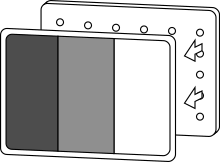
A computer monitor is an output device that displays information in pictorial or textual form. A discrete monitor comprises a visual display, support electronics, power supply, housing, electrical connectors, and external user controls.

A liquid-crystal display (LCD) is a flat-panel display or other electronically modulated optical device that uses the light-modulating properties of liquid crystals combined with polarizers to display information. Liquid crystals do not emit light directly but instead use a backlight or reflector to produce images in color or monochrome.

A light-emitting diode (LED) is a semiconductor device that emits light when current flows through it. Electrons in the semiconductor recombine with electron holes, releasing energy in the form of photons. The color of the light is determined by the energy required for electrons to cross the band gap of the semiconductor. White light is obtained by using multiple semiconductors or a layer of light-emitting phosphor on the semiconductor device.
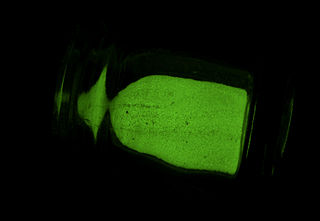
A phosphor is a substance that exhibits the phenomenon of luminescence; it emits light when exposed to some type of radiant energy. The term is used both for fluorescent or phosphorescent substances which glow on exposure to ultraviolet or visible light, and cathodoluminescent substances which glow when struck by an electron beam in a cathode-ray tube.

RGB color spaces is a category of additive colorimetric color spaces specifying part of its absolute color space definition using the RGB color model.
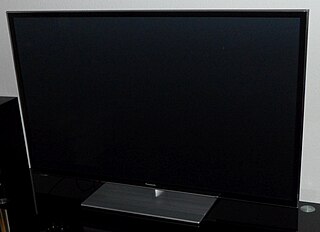
A plasma display panel is a type of flat-panel display that uses small cells containing plasma: ionized gas that responds to electric fields. Plasma televisions were the first large flat-panel displays to be released to the public.
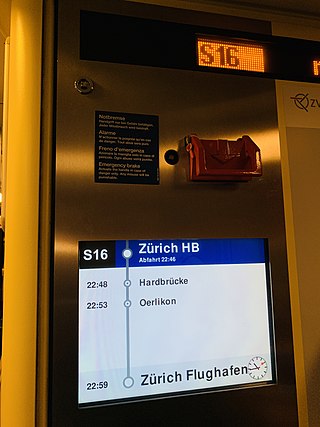
A flat-panel display (FPD) is an electronic display used to display visual content such as text or images. It is present in consumer, medical, transportation, and industrial equipment.

In color reproduction and colorimetry, a gamut, or color gamut, is a convex set containing the colors that can be accurately represented, i.e. reproduced by an output device or measured by an input device. Devices with a larger gamut can represent more colors. Similarly, gamut may also refer to the colors within a defined color space, which is not linked to a specific device. A trichromatic gamut is often visualized as a color triangle. A less common usage defines gamut as the subset of colors contained within an image, scene or video.

A video projector is an image projector that receives a video signal and projects the corresponding image onto a projection screen using a lens system. Video projectors use a very bright ultra-high-performance lamp, Xenon arc lamp, metal halide lamp, LED or solid state blue, RB, RGB or fiber-optic lasers to provide the illumination required to project the image. Most modern projectors can correct any curves, blurriness and other inconsistencies through manual settings.

A television set or television receiver is an electronic device for viewing and hearing television broadcasts, or as a computer monitor. It combines a tuner, display, and loudspeakers. Introduced in the late 1920s in mechanical form, television sets became a popular consumer product after World War II in electronic form, using cathode-ray tube (CRT) technology. The addition of color to broadcast television after 1953 further increased the popularity of television sets in the 1960s, and an outdoor antenna became a common feature of suburban homes. The ubiquitous television set became the display device for the first recorded media for consumer use in the 1970s, such as Betamax, VHS; these were later succeeded by DVD. It has been used as a display device since the first generation of home computers and dedicated video game consoles in the 1980s. By the early 2010s, flat-panel television incorporating liquid-crystal display (LCD) technology, especially LED-backlit LCD technology, largely replaced CRT and other display technologies. Modern flat-panel TVs are typically capable of high-definition display and can also play content from a USB device. In the late 2010s, most flat-panel TVs began offering 4K and 8K resolutions.
Nanosys is a nanotechnology company located in Milpitas, California and founded in 2001. The company develops and manufactures quantum dot materials for display products.
An output device is any piece of computer hardware that converts information or data into a human-perceptible form or, historically, into a physical machine-readable form for use with other non-computerized equipment. It can be text, graphics, tactile, audio, or video. Examples include monitors, printers and sound cards.
A thin-film-transistor liquid-crystal display is a type of liquid-crystal display that uses thin-film-transistor technology to improve image qualities such as addressability and contrast. A TFT LCD is an active matrix LCD, in contrast to passive matrix LCDs or simple, direct-driven LCDs with a few segments.
This is a comparison of various properties of different display technologies.
XBR is a line of LCD, OLED, Plasma, Rear Projection, and CRT televisions produced by Sony. According to Sony, XBR is an acronym for eXtended Bit Rate, although there is evidence that it originally stood for "Project X, Black Remote" which was meant to distinguish it from the then-standard line of Sony televisions. The XBR range is typically derived from equipment that has been released in Japan and Europe as mid and high-end models, usually with some small upgrades. For example, in Europe and Japan, the Sony X-Series 1080p TVs had two HDMI inputs, whereas on the American XBR version, there were three. Some XBR televisions may cost up to $25,000 USD.
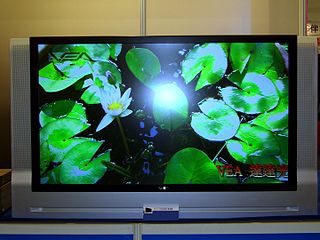
Large-screen television technology developed rapidly in the late 1990s and 2000s. Prior to the development of thin-screen technologies, rear-projection television was standard for larger displays, and jumbotron, a non-projection video display technology, was used at stadiums and concerts. Various thin-screen technologies are being developed, but only liquid crystal display (LCD), plasma display (PDP) and Digital Light Processing (DLP) have been publicly released. Recent technologies like organic light-emitting diode (OLED) as well as not-yet-released technologies like surface-conduction electron-emitter display (SED) or field-emission display (FED) are in development to supersede earlier flat-screen technologies in picture quality.
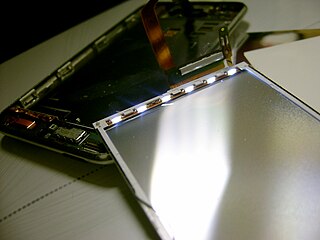
An LED-backlit LCD is a liquid-crystal display that uses LEDs for backlighting instead of traditional cold cathode fluorescent (CCFL) backlighting. LED-backlit displays use the same TFT LCD technologies as CCFL-backlit LCDs, but offer a variety of advantages over them.
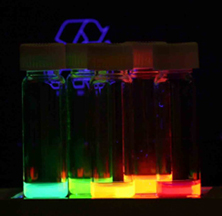
A quantum dot display is a display device that uses quantum dots (QD), semiconductor nanocrystals which can produce pure monochromatic red, green, and blue light. Photo-emissive quantum dot particles are used in LCD backlights or display color filters. Quantum dots are excited by the blue light from the display panel to emit pure basic colors, which reduces light losses and color crosstalk in color filters, improving display brightness and color gamut. Light travels through QD layer film and traditional RGB filters made from color pigments, or through QD filters with red/green QD color converters and blue passthrough. Although the QD color filter technology is primarily used in LED-backlit LCDs, it is applicable to other display technologies which use color filters, such as blue/UV active-matrix organic light-emitting diode (AMOLED) or QNED/MicroLED display panels. LED-backlit LCDs are the main application of photo-emissive quantum dots, though blue organic light-emitting diode (OLED) panels with QD color filters are now coming to market.
Nanoco Technologies Ltd. (Nanoco) is a UK-based nanotechnology company that spun out from the University of Manchester in 2001. The company's development has been driven by Dr Nigel Pickett, Nanoco's Chief Technology Officer, whose pioneering work on the patented "molecular seeding" process has formed the basis of Nanoco's unique technology. Since 2004, Nanoco has focussed its research efforts into the development and scale-up of quantum dots and other nanoparticles, including cadmium-free quantum dots. Nanoco's technology has been licensed to Dow, Wah Hong, and Merck, amongst others.
Polarizing organic photovoltaics (ZOPV) is a concept for harvesting energy from Liquid crystal display screens, developed by engineers from UCLA. This concept enables devices to use external light and the LCD screen's backlight using photovoltaic polarizers. Photovoltaic polarizers convert this light into electricity which can be used to power the device. This concept also provides multifunctional capability to devices with LCD screens as they act as photovoltaic devices and as polarisers.



